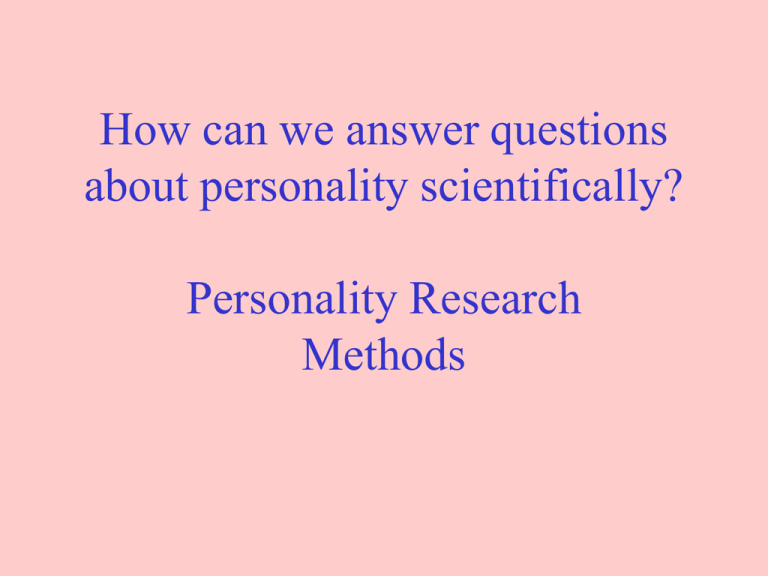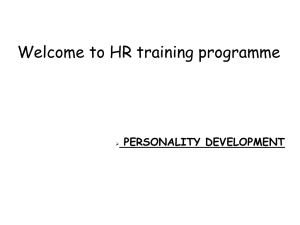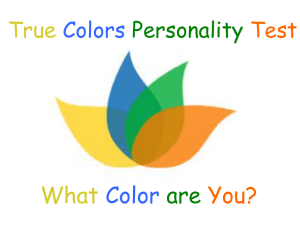
How can we answer questions
about personality scientifically?
Personality Research
Methods
Self-Identification Survey
Personality Research Methods
Goals –
1. Most generally, to become more sophisticated
consumers of research information
2. To understand how we study personality
empirically
3. To appreciate strengths and weaknesses of
various designs and analyses – what they can and
can’t tell us about personality
4. Be able to interpret some key types of statistics
Personality Research Methods
What is the purpose of research?
To, as objectively as possible:
• Evaluate theories
• Answer practical questions
In general, to accumulate knowledge in an
objective and public manner
Personality Research Methods
Three topics:
• Research design
• Interpreting data (statistics)
• Measurement (personality assessment, already
covered)
Personality Research Methods
Research Design
Two broad kinds of questions in research –
1) Is X related to Y?
• Are SAT scores related to GPA scores?
• Is emotional expressivity related to physical health?
2) Does X cause Y?
• Does medication cause symptom reduction?
• Does child abuse cause Borderline PD?
• Do genes determine sexual orientation?
Causality is “the big question”
Personality Research Methods
Research Designs
Types of research design
• Experimental
• Passive
• Case Study
Personality Research Methods
Research Design
Experimental Design –
• Manipulate a variable (IV) and measure
changes in another variable (DV).
• Random assignment to conditions (levels of
IV).
• Strengths and Limitations - Discuss
Personality Research Methods
Research Design
Passive Designs –
• Observe (measure) how pre-existing differences
between people on one variable are related to
differences between those people on another
variable
• E.g., drug abuse and psychological adjustment
• Why “Passive”?
• Strengths and Limitations – discuss
Personality Research Methods
Research Design
Case Studies –
• In depth analysis of specific entities (a person, a
group, an organization)
• Eg, Charles Whitman; Freud - the case of Little
Hans; Allport – “Letters From Jenny”;
• Strengths and limitations - discuss
Personality Research Methods
Research Design
Personality Psychology often uses Passive
Designs
Why?
Is Extraversion related to popularity?
Is Drug Abuse related to psychological
adjustment?
Personality Research Methods
Three topics:
• Research design
• Interpreting data (statistics)
• Measurement (personality assessment, already
covered)
Personality Research Methods
Interpreting Data
Statistics are nothing but tools to help us make
sense out of data.
We will typically:
• Look for group differences on some variable
• Look for relationships among variables
At one level, these are the same things.
Your BFI Data
A few questions to answer:
• Is personality related to happiness?
• Are there sex differences in personality?
• Is personality related to GPA?
• Do these associations/differences differ by
trait?
But first – how do we quantify/describe
associations/differences?
Personality Research Methods
Interpreting Data
Why worry about this?
• General sophistication in critical thinking?
• Ability to understand studies that we’ll be
discussing
Two general kinds of statistics:
1. Descriptive Statistics
2. Inferential Statistics
Personality Research Methods
Interpreting Data
Two general kinds of statistics:
1. Descriptive Statistics –
•
•
To summarize/describe the data that was
collected in a sample of subjects.
Examples – frequencies, means, standard
deviations, correlation
Personality Research Methods
Interpreting Data
Two General Kinds of statistics (continued)
2. Inferential Statistics –
•
•
•
To make statements/inferences about the
population(s) of people from which the
sample of subjects was drawn.
“Statistical significance”. Is the result
representative of the “population”?
Male and female samples (20 each) – find
difference in IQ. Is this representative of the
“population of males and females?
Personality Research Methods
Interpreting Data
What is a correlation?
• A correlation (r) is a number that summarizes
the direction and degree of association between
two variables
• Do people who have high SAT scores also get
relatively high GPAs?
• This is a question about the association
between two variables: SAT score and GPA.
Personality Research Methods
Interpreting Data
A correlation gives two pieces of info:
1. Direction of association
• + people who score relatively high on one variable
tend to score relatively high on the other
• - people who score relatively high on one variable
tend to score relatively low on the other
• 0 there is no relationship between the variables people who score relatively high on one variable
are likely to score either high OR low on the other.
• Note: “relatively”; “positive” ≠ good
Your BFI Data
A few questions to answer:
• Is personality related to happiness?
• Are there sex differences in personality?
• Is personality related to GPA?
• Do these associations/differences differ by
trait?
But first – how do we quantify/describe
associations/differences?
Personality Research Methods
Interpreting Data
A correlation gives two pieces of info:
2. Degree of association
•
•
How strongly related are the two variables?
Range from +1 (Very strong positive relationship)
to –1 (Very strong negative relationship)
• Values closer to zero represent “weaker”
relationships
So what would a “strong” correlation be? .90? .30?
.50?
Personality Research Methods
Interpreting Data
Interpreting a correlation – Is this relationship
strong or weak?
At least two ways to interpret the size of a
corr:
1. Research context
2. Translate to Probabilities (BESD, in textbook)
Statistical vs Experimental “Control”
What is experimental control? What do we
want to “control” when doing an experiment?
What if we can’t do so experimentally? –
Statistical control?
“Multiple regression”, partial correlations, etc
Example Conscientiousness, SAT, and GPA
Personality Research Methods
Goals –
1. Most generally, to become more sophisticated
consumers of research information
2. To understand how we study personality
empirically
3. To appreciate strengths and weaknesses of
various designs and analyses – what they can and
can’t tell us about personality
4. Be able to interpret some key types of statistics










